CES 2006 Part III - Samsung, XM Radio, Polk Audio, Dolby TrueHD
By Chris Boylan
Size Does Matter
Samsung enticed the press into their massive display area with the lure of free food and hot technology. The message this year from Samsung was "Open Architecture... Open Platforms." In other words, Samsung is concentrating on developing best-of-breed products compatible with other open industry standards instead of inventing their own standards. But this doesn't mean Samsung is sitting back letting other companies take the limelight at CES.
CES always features superlatives. Manufacturers play to the whole "boys with their toys" mindset and "mine's bigger" is the usual goal among the top TV manufacturers. Samsung was no exception in this respect.
Although Panasonic edged Samsung out for world's largest plasma TV this year (103 inches), Samsung still holds title to the world's
first 102-inch plasma which was big news at least year's CES. It sports 1080p native panel resolution but is not expected to see production any time soon. 102 inches is impressive, no doubt, but how many living rooms really need a TV this size?
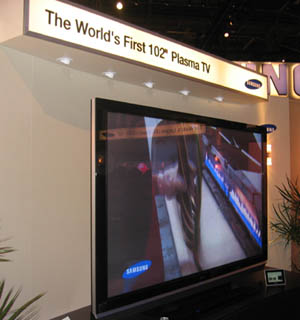
Samsung's 102 inch plasma is almost the world's largest flat panel TV.
Perhaps more interesting than the 102-inch plasma was Samsung's newest version of their 82-inch LCD flat panel prototype, the LN-S8297DE (pricing and availability TBD). Unlike a standard LCD TV, which is internally illuminated by incandescent bulbs, Samsung's new LCD TV prototype is illuminated by LED lights -- these offer higher brightness, better color accuracy, wider viewing angles and much longer lifespan than traditional LCD TVs. The 82-inch prototype sports a 1920X1080 (1080p) resolution and a rated contrast ratio of 7,000:1.
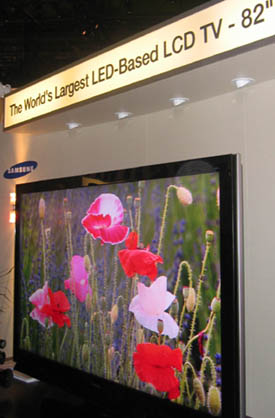
Samsung's prototype 82 inch LED-based LCD TV.
Samsung has also expanded their popular DLP rear-projection (RPTV) line with several new models, one of which features LED illumination. Samsung claims that the LED-based DLP light engine offers at least 20,000 hours of active use with no drop in brightness levels. The upcoming HL-S5679W (MSRP: $4199, available April, 2006) features a 56-inch diagonal screen, LED illumination. integrated ATSC tuner, 1080p native resolution and two 1080p-compatible HDMI inputs.
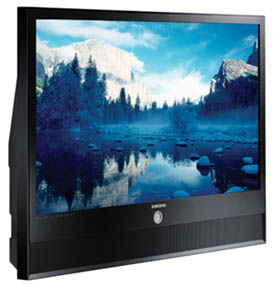
Samsung's HL-S5679W 56 inch DLP HDTV features LED illumination and 1080p resolution.
And of course, what good is a 1080p BIG PICTURE with nothing to play on it? To this end, Samsung announced the earliest ship date for their upcoming High Definition Blu-Ray Disc player, the BD-P1000, which is expected to ship in "early Spring" at a retail price of $1,000. The Samsung BD player includes a unique single-pickup/dual lens system that allows it to play the new Blu-Ray discs as well as standard CDs and DVDs. On the DVD front, it supports playback of every DVD known to man, including DVD-RAM, DVD-RW, DVD-R, DVD+RW, and DVD+R, but NOT HD-DVD. Despite earlier rumors that Samsung would make and market a dual Blu-Ray/HD-DVD player, there have as yet been no formal statements (or even suggestions) from Samsung that this would be the case any time in the foreseeable future.

Samsung's BD-P1000 will play just about every silver disc imaginable except HD-DVD.
In the standard definition DVD-Recorder department, Samsung announced 10 new models, the most interesting to our readers being the DVD-HR731 ($499 MSRP, available June, 2006). It's a unified HDD/DVD-Recorder, which includes DVD-RW/-R recording and a 160GB hard disk drive. It features the EPG TV Guide Plus onscreen guide, plus a front-panel DV input for ease of use with digital camcorders.

Samsung's DVD-HR731 will feature a 160 GB HDD, firewire DV Input and the free TV Guide OnScreen guide.
On the (much) smaller picture side of things is Samsung's YM-P1 portable media player/recorder (MSRP: $399 for 20 GB version, or $499 for 30 GB version) which is expected to ship to dealers in February, 2006. Unlike many play-only models, the YM-P1 also offers on-board recording via an integrated A/V input jack. It sports a 4 inch 16:9 screen. I noticed a slight lip-sync delay in the audio on the demo material (one of the "Lord of the Rings" films), which I hope was an encoding artifact, and not a problem with the player itself.
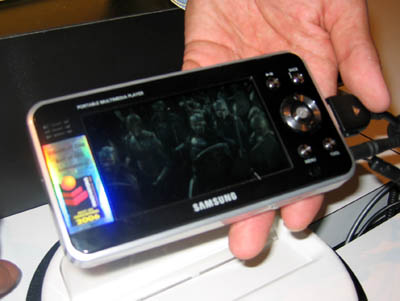
Samsung's YM-P1 portable media player also records via a built-in A/V input.
Things were even more interesting on the portable audio side of things at Samsung with the announcement and display of their upcoming portable XM Radio/MP3 player, the Helix XM2go player.
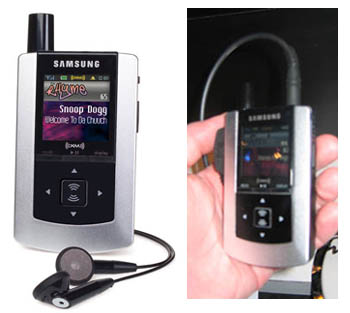
Samsung's Helix XM2go player (MSRP: $399, including home docking station) is expected to ship in the first quarter of this year.
Satellite Radio - You Can Take it With You!
The Helix offers live XM reception, plus storage and playback of up to 50 hours of MP3s, WMA files, and XM content for portable listening. The Helix lets the user "bookmark" songs heard on XM for online purchase from the XM + Napster online service. The diminutive little player weighs in at only 4.5 ounces and measures approximately 3.7 inches high, 2.2 inches wide, and 0.6 inch deep. This makes it about half the size of the previous XM2go units from Pioneer, Tao and Delphi with room for 10 times as much content as well as mp3 compatibility. We may need to take a closer look at this promising little unit as it nears production.
XM had other big news at this year's CES, namely XM's "HD Surround" -- a new 5.1-channel surround sound feature that will be available first on home receivers made by Onkyo, Pioneer, Denon and Yamaha. Beginning in March 2006, XM will broadcast the free-form music channel Fine Tuning (XM Channel 76) and the classical pops music channel XM Pops (XM Channel 113) in XM HD Surround. XM will also broadcast a variety of special shows and live music performances at the XM studios in XM HD Surround.
I heard a demo of this technology, which was developed in partnership with Neural Audio Corporation, and I must say it was pretty impressive. I also had a brief, but mind-bending conversation with one of the XM engineers behind this innovation. I am not ashamed to say I understood less than half of what he was saying but the gist of it was that it's discrete (not matrixed) 5.1-channel sound but it's also backward compatible with legacy XM equipment so it won't affect the sound quality of those who listen to these broadcasts in standard stereo mode.
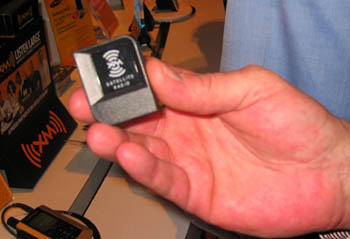
XM's new Passport transportable tuner module will be sold by Audiovox.
XM was also showing off their new plug-and-play XM tuner module called the "Passport" which squeezes all of the XM reception and decoding technology into a device the size of a digital camera battery (1.3 inches wide, 1.65 inches long, 0.44 inches thick). The XM passport will be transportable between home and mobile XM-ready devices, allowing you to enjoy XM radio anywhere you want, but pay just one monthly subscription fee. The unit itself will hit the streets in March at a list price of $29.99 and requires a home or car docking station ($29.99 each) or a passport-compatible device such as a home theater receiver, a portable player or even a clock radio.
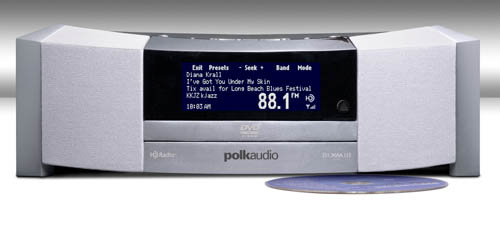
Polk's I-Sonic incorporates AM/FM/XM and HD Radio with a DVD/CD player and high quality speakers in one compact chassis.
And speaking of clock radios, when is a clock radio a true high performance audio/video component? When it's made by Polk Audio, of course. Polk's I-Sonic is billed as the "Complete Digital Entertainment System." Not only is it XM-ready, but it also includes a built-in DVD/CD player, plus on-board AM/FM and HD Radio tuners. Most of the internal cabinet volume is used as the enclosure for the woofer which gives the little guy some pretty prodigious bass. The i-Sonic will sell for $599 (MSRP) and is expected to begin shipping in March of this year. And while this may not truly qualify as "home theater," it does make a fine second system where space is at a premium and simplicity is a must.
And in keeping with the "simplified home theater" theme, Polk was also demonstrating their single cabinet home theater speaker system, the SurroundBar ($949.95, available now). The Surround Bar offers those who simply can't (or don't want to) install side or rear surround speakers into their living room a viable alternative for surround sound. The SurroundBar delivers an enveloping surround sound experience from a single, multi-driver loudspeaker located below (or above) the TV screen. It uses Polk's patented "SDA Surround" technology to enhance the width and depth of the soundstage to the point that you'd swear there are more speakers around the room.
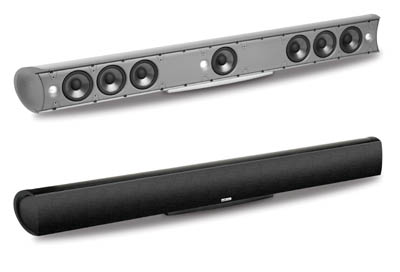
Polk's Surround Bar is available in titanium or black.
The demo was pretty convincing, and even more so the further you got from the TV (within reason). While it never really seemed that sound was coming from behind me, the width of the soundstage was huge - much larger than the physical dimensions of the cabinet - and the surround channels seemed to be located to my immediate left and right with no physical speakers there to be found. This definitely could represent a tidy solution for the "rear-speaker-installation-challenged" and I'm requesting a review sample from the Polk folks so I can evaluate this technology up close and personal.
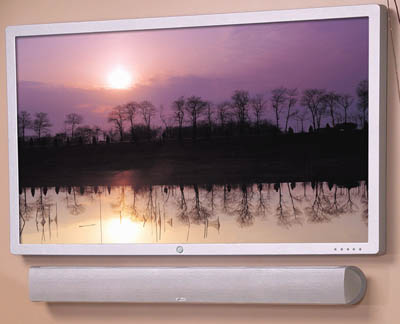
Polk's SurroundBar fits nicely with a flat-panel display.
Wrapping things up for this segment was a live demo of
Dolby's new True HD surround sound system. Dolby Digital is, of course, part of the audio standard adopted by both BluRay Disc and HD-DVD. Dolby's "TrueHD" option supports up to 14 channels of audio with up to 24bit/192KHz sampling per channel. Though it is more likely that content providers will "settle" on Dolby True HD tracks with 7.1 channels of audio content to provide some degree of uniformity and consistency with current audio systems.
A lossless encoding option using Meridian's MLP (Meridian Lossless Packing) can store this multi-channel audio data in much less space than standard PCM-encoding but with zero loss in quality.
So what we're looking at (or listening to, as the case may be) is audio quality that exceeds what's possible using current DVD-Audio or SACD technology, with the added bonus that both HD-DVD and Blu-Ray disc support video as well. If the demo I heard of Dolby TrueHD is any indication of what we can expect from commercial releases, then no matter which disc format triumphs, audiophiles are in for a treat!
Continue on to Part IV to find out more about
Sharp's newest LCD TVs, Pioneer's Blu-Ray Disc player, new projectors from InFOCUS and LG and big news from the BDA (Blu-Ray Disc Association).
Just joining us? Why not
start at the beginning of our CES 2006 home theater coverage?.










